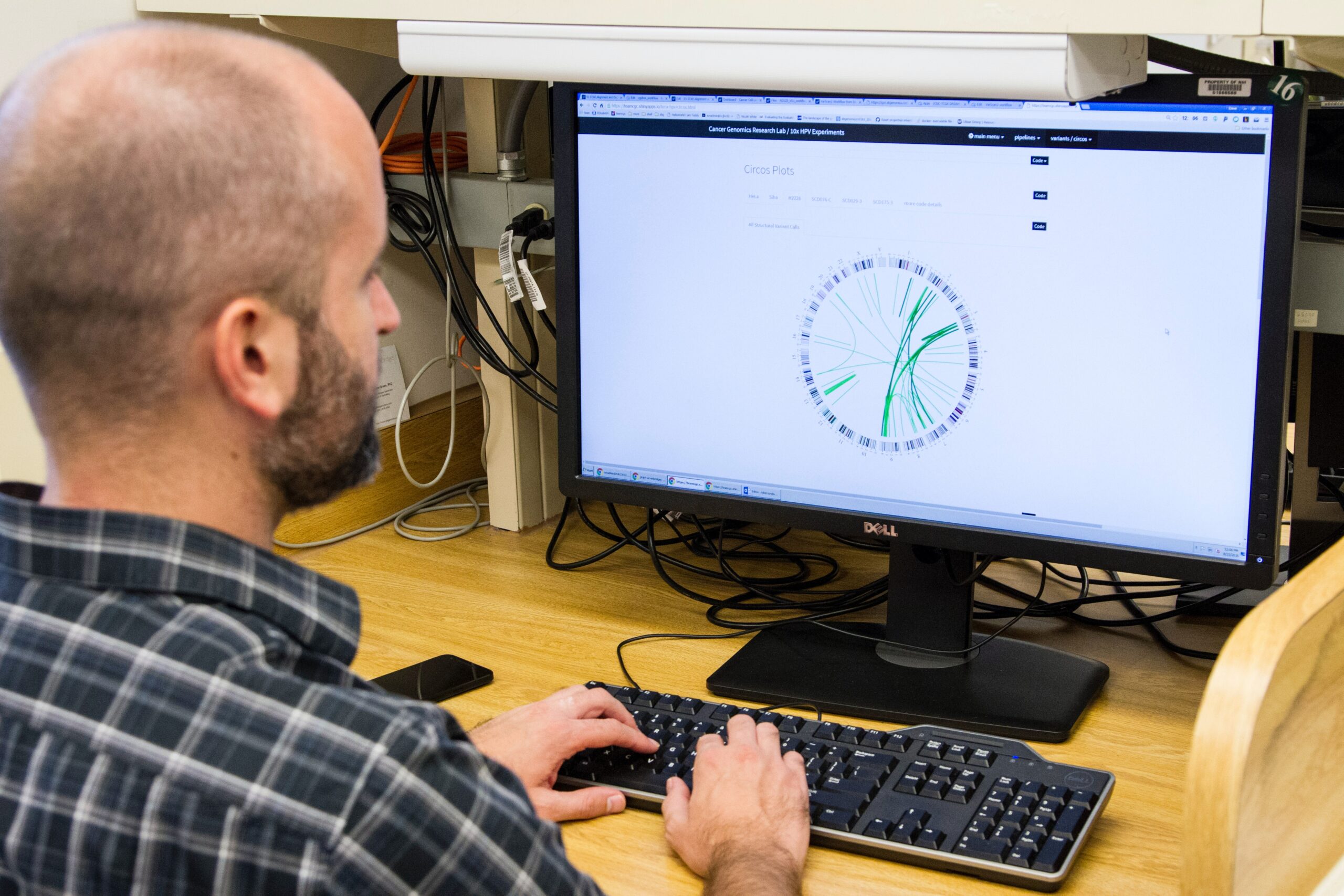Biotechnology thrives at the intersection of biology and technology, constantly seeking to push the limits of what’s achievable. As this vibrant field plunges deeper into uncharted territories, it searches for tools that match its pace and ambition. Enter Software as a Service (SaaS). Offering more than just a cloud-based software solution, SaaS equips biotech professionals with real-time data insights, fosters cross-continent collaboration, and sidesteps the cumbersome traditional IT infrastructure.
This post explores how SaaS is reshaping the contours of biotechnology, offering a fresh lens to view and navigate its dynamic landscape.
The Biotechnology Sector’s Shift to SaaS
In biotech, labs filled with petri dishes, microscopes, and researchers once used to be the norm. But with the disruption of SaaS, things are changing. Here’s a look at how SaaS solutions are redefining work processes and pushing boundaries in the biotech space.
Streamlined data management
Biotech relies heavily on data. From genetic sequences to protein interactions, the volume is vast. Enter SaaS. Platforms today offer centralized data storage with a twist. Researchers can upload raw data, and within moments, the software processes, analyzes, and even suggests patterns. No longer do scientists need to jump between software or lose hours in manual analysis.
Collaboration Without Boundaries
The heartbeat of biotechnology is teamwork. When researchers from diverse backgrounds unite, the results often surpass the ordinary. Enter SaaS, the digital toolset that’s redefining how these collaborations happen.
Researchers, regardless of their location, now find common ground on SaaS platforms. Distance? Just a word. These platforms foster an environment where ideas flow unhindered. From one continent to another, insights and findings merge effortlessly.
Key benefits of SaaS in promoting biotech collaboration:
- Unified platforms: Instead of juggling multiple tools, teams converge on one platform. This centralization ensures that everyone speaks the same technological language.
- Real-time feedback: A discovery in one part of the world can be reviewed, critiqued, and built upon by another team in a different time zone—all in a day’s work.
- Seamless software integration: SaaS platforms are designed for compatibility. Whether it’s data analysis software from Team A or a genetic modeling tool from Team B, integration is smooth.
- Open forums for debate: Science thrives on questioning and challenging. These platforms host spaces where researchers can debate, discuss, and refine theories—pushing the boundaries of what’s known.
The landscape of biotechnology is vast and varied. But with SaaS, the distance between labs, between researchers, shrinks. As they come together on these platforms, a new era of innovation dawns—marked by shared goals, collective effort, and boundary-pushing discoveries.
Strengthening Biotech’s Stakeholder Engagement with SaaS
The biotech sector is more than just labs, microscopes, and data—it’s a network of passionate individuals, institutions, and stakeholders, all striving towards a common goal. And with the rise of SaaS, the way federated learning happens is undergoing a significant transformation.
Forging Stronger Partnerships
Stakeholders, be it research partners, investors, or suppliers, are vital cogs in the biotech machine. SaaS simplifies and enhances these intricate connections. A supplier in Europe can seamlessly update a research team in Asia about a shipment, or an investor in North America can access real-time reports from a start-up they’ve funded halfway across the world. This instant, transparent communication fosters trust and expedites processes.
Enhancing Decision-Making
In biotech, making informed decisions can often mean the difference between a breakthrough and a setback. With SaaS platforms, stakeholders have access to vast repositories of knowledge, insights, and trends. No more waiting for quarterly reports or annual reviews. Stakeholders can dive deep, ask the right questions, and chart informed paths, ensuring the entire ecosystem moves coherently towards its goals.
Tailored Solutions for Varied Needs
Different stakeholders have different needs. A research institution might prioritize data sharing and collaborative tools, while a venture capitalist is more interested in financial projections and market analytics. SaaS offers bespoke solutions, ensuring every stakeholder finds the tools and interfaces that resonate with their specific needs.
Building a Community
Beyond the tangible benefits, SaaS also plays a crucial role in fostering a sense of community among stakeholders. Online forums, webinars, and collaborative platforms provide spaces for stakeholders to exchange ideas, share experiences, and even brainstorm solutions to common challenges. This communal approach not only accelerates individual projects but also catalyzes the industry’s overall growth.
Streamlining Regulatory Compliance in Biotech
Biotech walks a tightrope of regulations. It’s tough. It’s essential. SaaS lightens this load, making compliance smooth and more efficient.
Real-time Regulatory Updates
Regulations change and often. SaaS platforms offer real-time tracking that removes the need to manually scan regulatory websites or read lengthy email threads. When a rule changes, you know immediately.
Tailored Compliance Dashboards
Each biotech firm is unique. So is their compliance journey. Modern SaaS solutions offer customized dashboards. You see what matters to you. Missed a critical update? The dashboard flags it. Need to review a past compliance report? It’s a click away.
Integrated Document Management
Paperwork piles up, especially in biotech. SaaS platforms come with integrated document management systems. Store, retrieve, and share documents with ease. It’s all stored and organized in one place.
Training and Knowledge Dissemination
New regulations often mean new protocols. SaaS platforms aren’t just about monitoring— they offer training modules too. Teams get up-to-speed on the latest rules without leaving their desks. Plus, there’s consistent training for everyone without any variations or gaps.
Feedback Loops with Regulatory Bodies
Communication is two-way. SaaS doesn’t just track and inform. Some platforms allow biotech firms to communicate directly with regulatory bodies. Queries, clarifications, or feedback – it’s streamlined, direct, and efficient.
Risk Assessment Tools
Mistakes in biotech can be costlyy. Some SaaS tools now offer risk assessment modules. These tools evaluate potential compliance risks. They highlight red flags as well as offer mitigation strategies.
Audit Readiness
Audits are inevitable in biotech. SaaS ensures you’re always ready. How? Through continuous compliance checks. Everything’s logged, tracked, and timestamped.
Key Solutions Making Waves
The intersection of SaaS and biotechnology has led to the creation of new solutions across certain domains. The following are a few worth mentioning:
- Lab Management Systems
Gone are the days when researchers scribbled notes and maintained physical logbooks. Modern labs are dynamic. They demand real-time data access and seamless collaboration. Cloud-based lab management systems, such as Labguru or Benchling, facilitate this. They streamline inventory management, experiment scheduling, and data analysis. The best part? Everything’s accessible anywhere, anytime.
- Genome Analysis
Sequencing a genome produces heaps of data. Decoding this data? That’s another challenge. Cloud-based platforms, like DNAnexus, have changed the game. They allow researchers to upload, analyze, and interpret genomic data with ease. The cloud’s vast storage and processing capabilities mean quicker insights and breakthroughs.
- Drug Discovery Platforms
Drug discovery is a time-consuming, costly affair. SaaS platforms, like Schrödinger’s suite of tools, simplify this. By leveraging cloud-based computational power, they accelerate drug discovery processes. Researchers can run simulations, predict molecular interactions, and assess drug viability—all in the cloud.
- Clinical Trial Management
Clinical trials are the backbone of biotech innovation. But they’re complex. They involve patient data, regulatory compliance, and intricate logistics. SaaS solutions, such as Medidata or Oracle’s Clinical One, streamline this. They offer tools for patient recruitment, data collection, and reporting. With cloud-based access, stakeholders stay in the loop, ensuring smoother trials.
- Bioinformatics Platforms
As biotech data burgeons, the need for sophisticated analysis tools grows. Platforms like Galaxy or Bioconductor, operating in the cloud, empower researchers. They can run complex algorithms, visualize data patterns, and derive meaningful insights, all without heavy local infrastructure.
Benefits of These Platforms
SaaS biotech solutions aren’t just about convenience. They’re transformative. Here’s how:
- Cost-effectiveness: With SaaS, you ditch the hefty upfront costs of software installations. Pay-as-you-go models ensure you only pay for what you use.
- Scalability: Scaling up? No problem. The cloud grows with you. Whether you’re analyzing a handful of samples or millions, SaaS platforms adapt.
- Knowledge sharing: Science is a collective endeavor. Cloud-based solutions foster teamwork. Researchers, spread across the globe, can work together in real-time.
- Security: Contrary to some beliefs, the cloud is secure. SaaS providers invest heavily in encryption, data backups, and regular security audits. Your data is in safe hands.
- Regular Updates: The biotech field never stands still. And neither do SaaS solutions. With cloud-based tools, you enjoy regular updates. No manual installations, no downtime. Just seamless access to the latest features.
Integrating SaaS Into Your Operations
If you run a biotech firm, there are certain steps you can take to adopt SaaS for your company:
1. Identify Specific Needs and Prioritize
- Assess your current system: Before diving into SaaS solutions, evaluate your existing system. Understand where the bottlenecks and inefficiencies lie.
- List down needs: What do you expect from a SaaS solution? Is it data storage, genome analysis, lab management, or perhaps clinical trial oversight? Prioritize what’s crucial for your operations.
- Seek feedback: Engage with your team. Their on-the-ground insights will highlight practical challenges and requirements you might overlook.
2. Research and Choose the Right SaaS Provider
Not all SaaS solutions are made equal. Look for providers who cater specifically to biotech needs. They’ll offer features tailored to your industry. Many SaaS providers offer demos or trial periods, so you can test waters before making a contract. This hands-on experience will give you a feel for the platform’s capabilities and usability.
Also ensure your chosen SaaS provider has robust encryption, frequent backups, and a transparent privacy policy. Data security is non-negotiable in biotech.
3. Plan and Execute a Smooth Transition
Migrating data from your current system to the SaaS platform is critical. Plan this well to ensure no data is lost or corrupted during the shift. If your firm is still using some on-premise tools, ensure the SaaS solution integrates seamlessly with these. It will save you countless headaches later.
Lastly, organize training sessions. Encourage your team to explore the platform, ask questions, and become comfortable using it. Remember, even the best SaaS platform is useless if your team struggles with it.
4. Monitor, Iterate, and Optimize
Once the SaaS solution is in place, regularly check in with your team. Gather feedback on any hiccups, challenges, or additional needs. Additionally:
- Liaise with the SaaS Provider: Maintain an open line of communication with your SaaS provider. They can offer solutions to challenges, inform you of upcoming features, or even customize certain aspects for your needs.
- Stay updated: The world of SaaS is dynamic. Updates roll out frequently. Ensure you’re making the most of these. They often come with enhanced features or improved security measures.
5. Plan for Future Scalability
As your firm grows, your SaaS needs will evolve. Familiarize yourself with the scalability options your provider offers. Can you easily upgrade storage, add new features, or integrate additional tools?
While SaaS is cost-effective, growing your operations will likely incur additional costs. Plan for these. Factor them into your financial projections.
Lastly, know that the biotech industry, much like the SaaS world, evolves rapidly. Be prepared to adapt, change, or even switch your SaaS solutions as new needs arise or better technologies emerge.
Conclusion
For emerging biotech firms, harnessing SaaS solutions is more than just optimizing today’s operations. It’s about envisioning and preparing for a technologically-advanced future. With SaaS’s inherent scalability and adaptability, biotech organizations can readily navigate the challenges of tomorrow. As we stand on the precipice of rapid technological growth, those who embrace tools like SaaS will undoubtedly lead the industry’s evolution.


